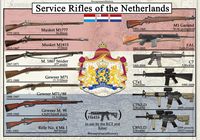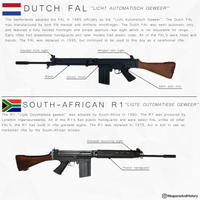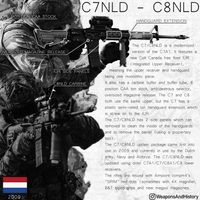History of Dutch service rifles
All Dutch service rifles from 1777 - 2023
It all started in the Dutch Republic, the musket M1777 became the first standard issue rifle. A copy from the famous French M1777 musket. It used a flintlock mechanism (which is originally a dutch design). The rifle had a bore of 16.45mm. In 1815, after the creation of the Kingdom of The Netherlands. The M1815 musket was adopted.
The M1815 was a new Dutch rifle. It was based of the M1777. The rifle had a bore of 17.5mm and had a flintlock action. The M1815 was used by the Royal Dutch army during the battle of Waterloo, together with British Pattern India muskets and older M1777 rifles. In 1829, the M1829 ''Jagersbuks'' was adopted, a shorter and rifled version of the M1815 (i forgot to add this one to the list). In 1841, most of the rifles were converted from flintlock to percussion rifles. Around the 1860's, some muskets were converted to breech block rifles. There is also the M1848 rifle, there is not much information about it.
In 1867, muzzle loaded rifles were outdated. The Netherlands converted muzzle loading rifles and converted rifles to use a Snider breech loading action and using a metallic cartridge. Designated the M1867 (depends also on the type of rifle being converted, like the M1848-67). This rifle was used a temporarily option. Somewhat over 83,000 M1848/67 Dutch Sniders were converted; 30,000 arms were produced by the P. Stevens Company of Maastricht, 30,000 by the Birmingham Small Arms Company, an additional 23,000 by the firm of Geweerwinkel c.g. WDW (Werkplaas voor Draaglau Wapenen, “workplace for portable weapons”) in Delft. The rifles were chambered in the 17.5mm Dutch Snider. Not the .577, my mistake in the photo.
In 1871, a new domestically designed rifle was adopted. The Geweer M1871 (rifle model 1871), or more commonly named the Beaumont, named after its inventor. The Beaumont used a bolt action mechanism with the bolt handle (the entire block) acting as the locking lug. The Beaumont was chambered in the 11.3x50mm cartridge and it is single shot. The spring for the firing pin is housed inside of the bolt handle. So the bolt handle can not be bend, so the cavarly used Remington rolling block rifles. The Beaumont was well liked rifle and was exported for trials to other countries. There was also the M1873 colonial rifle for the KNIL (koninklijk nederlands indisch leger, royal dutch east indies army), with little changes to the finish to prevent corrosion in the humid east indies climate.
After the invention of smokeless powder and the use of small caliber cartridges. The Netherlands decided to upgrade the existing M1871 rifles, the M1871/88 or ''Beaumont-Vitali'' uses a 4 round vitali megazine. It increases the firing rate extensively. The magazine had a cut off, since the rifle was still meant to be used a single shot rifle, and use the magazine in emergencies.
In 1895, it was time for the Dutch military to adopt a new smokeless, small caliber rifle. But at this time the army didn't have the money to buy thousands of rifles to be field-tested, so the MOD looked at what other nations picked. The Netherlands chose the same rifle Romania adopted in 1893. The Mannlicher M1893, a bolt action en-bloc fed rifle. The Netherlands bought the first couple of thousand rifles with some slight changes and later the rifles were manufactured at Artillerie Inrichting.
Chambered in 6.5x53mmR, the M.95 (sometimes called Mannlicher) is a bolt action rifle and not a straight pull rifle (most people think its a straight pull because some people call it a Mannlicher). The action is the same as a Mauser 88, same 2 lug bolt and firing pin mechanism. The Magazine is the same as from a Mannlicher 95 (dimensions are still different). It's en-bloc fed and not from stripper clips. At the last round, the rifle poops out the empty clip.
The rifle saw action in WW2 (The Netherlands was neutral in WW1) and it was outdated, too heavy, too long, and not well maintained. There are stories of the rifles being really inaccurate etc. But the rifle was a real workhorse, it was reliable and worked well (for most soldiers). In the East Indies, the rifle was not that practical, jungle warfare with such a long rifle was impractical (the rifles not the carbines), and after the Japanese invasion japan used it to maintain the colony and after WW2, the dutch used the M.95 in small numbers, and it was still used for years by the Indonesian army. There are many carbine variants of the rifles and theyre listed here
Karabijn no.1: For the cavalry, mareschaussee (military police) and colonial army (KNIL)
Karabijn no.2: For the mareschausee
Karabijn no. 3: For the artillery and pioneers
Karabijn no.4: For bicycle troops
Karabijn no.5: Converted M.95 rifles to carbines
Then there are the new and old models too.
During the occupation of The Netherlands by the Germans and later Japanese. The Germans and Japanese both captured the M.95 rifle and used it themselves (under the German designation G211 (H), and the Dutch government and army being in exile in Britain, the Dutch army adopted Rifle No.4 Mk.1 (im going to call it the Lee Enfield for simplicity). The KNIL (colonial army) also ordered a bunch of M1941 Johnson rifles and Thompson submachine guns, where only a few got supplied to the KNIL. The Dutch Free Army also used M1917 rifles during the liberation of The Netherlands. During and after World War 2. The Dutch army got supplied Lee Enfield and M1 Garand rifles from the allies, and the Lee Enfield became the standard issue rifle and was heavily used during the Indonesian war of independence. The Lee enfield is also a bolt action rifle and is chambered in .303 British, its being fed by a 10 round magazine (fun fact, during the rifle trials in the 1890's, the lee enfield was dissqualified because of the stripper clips giving the soldiers cuts in their finger, and now the rifle is standard issue). In 1952, the M1 Garand was the new standard issue rifle together with the Uzi submachine gun and M1 carbine. The M1 garand is chambered in the .30-06 and is being fed by 8 round en-bloc clips. The M1 uses a long stroke gas piston and a rotating bolt.
It was time for the Dutch to standardize to the 7.62x51mm NATO cartridge, and after a fierce and long competition between the AR-10 and FAL. The FAL (Licht Automatisch Geweer) was adopted in 1965. The FAL is chambered in 7.62x51mm Nato and is being fed by 20 round magazines. The FAL uses short stroke gas piston and a tilting bolt. The Dutch FAL has some characteristics, it has a winged rear sight (not adjustable for range), a glossy black finish, sheetmetal handguard with bipod and a fully hooded front sight. Later around the 80's and 90's the rifles did had plastic handguards and stocks. The dutch marine corps also used the FALO, a heavy barrel light support weapon variant of the FAL. For more about the FAL, check out this post.
In the 1990's (?), the Dutch army tested out different assault rifles. The FNC, L85A1, AR70/90, M16A2, Galil model 708, AUG, C7 and Cetme L. And ultimately, the C7 was chosen as the new standard issue rifle and it was adopted in 1995. The C7 was adopted as a family of weapons. The C7 and C7A1* rifles, C8 and C8A1 carbines and the C7 LSW (A1 features a flat top upper receiver with Elcan C79 optical sight). The C7 is chambered in 5.56x45mm NATO, it uses stoners internal piston system and a multi lug rotating bolt. The rifle was being adopted during the Yugoslav wars, during UN operations you can see Dutch troops carrying both the C7 and FAL. The C7 was made by Diemaco in Canada, and the rifle was usually simply called the Diemco. The C7 was used during the war in Afghanistan, where it showed that it was time to modernize the rifle. Ending up in the C7NLD and C8NLD. The C7NLD features a new IUR (Integrated Upper Receiver), meaning the upper receiver and handguard is one monolithic piece, a carbine buffer and buffer tube with a 6 position collapsible CAA stock (fun fact, the stocks sat too loose on the buffer tube so theres a piece of tape sticker to the buffer tube to stop it from ratteling), a ambidextrous fire selector, oversized magazine release and new accesoires like a aimpoint compm4 red dot and B&T grip pod. Back to the IUR, the C7 and C8 both use the same upper receiver, but the C7 feauteres a longer 20 inch barrel and uses a plastic handguard extension. The IUR features a side panel on each so youte able to kinda clean the inside of the handguard. Diemaco got rebranded to Colt Canada, and the C7 and C8NLD was simply called the Colt. For more about the C7 and C7NLD, check out this post!
The HK416 was adopted by the Korps Commandotroepen (special forces) in 2010 replacing the C8A1GD, and in 2019 the mareschaussee (military police) adopted the HK416 as the standard issue rifle for their branch, replacing the MP5 and C8NLD. The HK416 is similair the C7NLD but it uses a external short stroke gas piston.
In 2022, the Dutch military started a search for a new military rifle. Now we have to wait.


